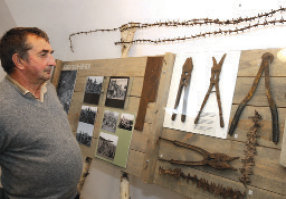Museum exposition about the First World War created in Postavy

In one of exhibition halls
Thematic exhibition occupies four halls of renovated Tyzenhaus Palace basement. “Postavy is directly connected with the First World War, being almost three years at the front. All the exhibits are from the Local History Museum, which boasts a rich collection of objects from that time. Many were found in the district, some being owned by families,” explains Postavy Regional Local History Museum curator Vadim Shishko.
Regional ethnographers from Postavy explain that the exhibition comprises four parts: one with general information about the war; others looking at German and Russian entrenchments; and the last named ‘Life and Death’.
Mr. Shishko notes, “Among our museum objects are many interesting artefacts: fragments of original German barbed wire, wooden posts, various missiles, a glass flask, and a bottle with liquid for clearing gas masks (used by Russian soldiers). Gas masks were less common in the Second World War, since it was only in the first that gas was widely used.” Some stands remain empty, waiting for new artefacts to arrive. Mr. Shishko adds, “Residents of the city and district constantly bring in new objects, so we’ve left plenty of room.”
A considerable quantity of German fortifications existed in the district, so helmets and shields have been found. Mr. Shishko continues, “Germans aspired to make their stay during the war as comfortable as possible; the iron bed and portable stove in our exhibition are evidence of this.”
The fourth hall aims to show that the war years embraced ordinary life as well as conflict. You can see the passports given out by German authorities to the inhabitants of Lyntupy, which contain not just data on the person and their photo but fingerprints.
“Most soldiers were young guys, who spent 2-3 years sitting in trenches. They met local girls and quite often asked permission to marry girls from Postavy. Quite a few such permissions were granted, as we know from evidence,” Mr. Shishko underlines. Various items from civil life, left by soldiers, are also on display: ice-skates, cheese wrappers, beer bottles, confectionary boxes, cigarettes and cans. He adds, “The First World War was inherently conducted in the trenches, with soldiers living there for a long time — through winter, spring and autumn, in the dirt and cold, ankle-deep in water. As a result, they suffered from cold-related and infectious diseases, and many died.”
Of the many cemeteries in the district, only some containing Germans have been maintained, while some of those for Russian soldiers remain unknown.











